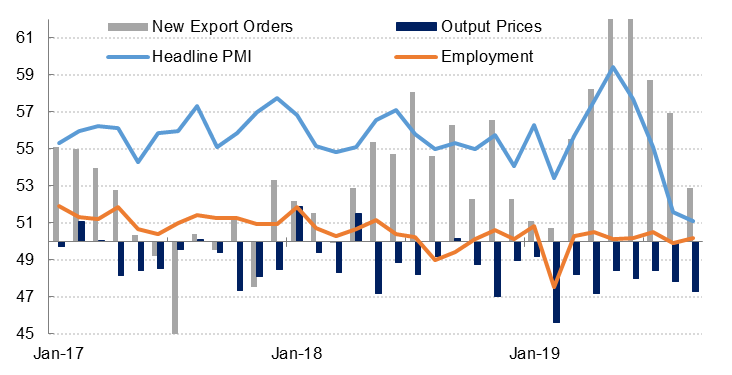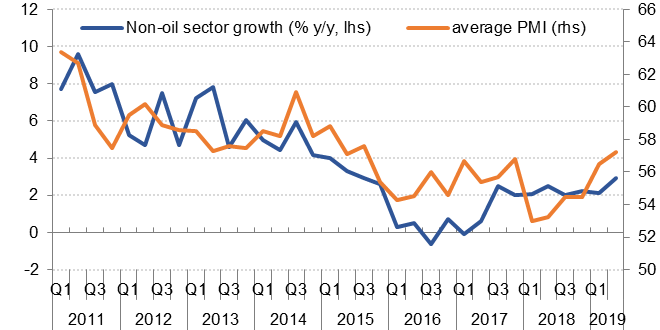
The headline PMI for the UAE slipped to 51.1 in September from 51.6 in August, the lowest reading since May 2010. The main driver appeared to be slower growth in new work, and particularly new export orders which signals weaker external demand after a strong Q2.
The weakness in new orders was in spite of further price discounting on the part of firms, which cut selling prices even as input costs rose in September. The employment index recovered to 50.2, but this points to only fractional job growth in the non-oil private sector last month.
Backlogs of work declined for the first time since December 2016, indicating excess capacity in the UAE’s non-oil sectors. Purchasing activity slowed sharply, likely due to softer new order growth, and the stocks of inventories was unchanged from August. While firms remain optimistic on average, they are less optimistic than they were in Q2 2019, with more than half of firms surveyed expecting their output to be unchanged in twelve months’ time.
The average PMI reading in Q3 was 52.6, the lowest since Q1 2012, and signals a deceleration in non-oil sector growth after an improvement in the first half of this year. Output and new work grew at the slowest rate since Q1 2016, despite further price discounting. Private sector job growth was only marginal in Q3, as it has been over the last 12 months.
 Source: IHS Markit, Emirates NBD Research
Source: IHS Markit, Emirates NBD Research
In contrast, PMI survey data for Saudi Arabia suggest that non-oil sector growth has remained stable in Q3 2019. The headline PMI rose to 57.3 in September and the average for Q3 was 57.0, similar to the Q2 reading of 57.2. Both output and new work indices remained elevated above 60.0, even as new export orders grew at a slower rate.
This supports our view that it is domestic demand, underpinned by government spending, that is driving growth in the kingdom’s non-oil sectors. However, the growth in output and new work has not translated into significantly faster job growth in Saudi Arabia. While the employment index rose to an 18-month high in September, at 51.5 it is only slightly higher than the “no change” level.
Official data shows that non-oil sector growth in Saudi Arabia accelerated to 2.9% in Q2 2019, the fastest rate of growth since Q3 2015. The average PMI reading for Q2 2019 was also the highest since Q3 2015, and has remained at a similar level in Q3, suggesting that non-oil sector growth in the third quarter was likely also around the 2.5-3% mark.
 Source: IHS Markit, Emirates NBD Research
Source: IHS Markit, Emirates NBD Research
The headline PMI for Egypt was fractionally higher in September at 49.5 but remains in contraction territory. Both output and new work declined in September, and new export order growth slowed. However, the employment index rose to 51.5 last month, the highest reading since August 2018 and marks the second consecutive month of private sector job growth. Staff costs also rose at the fastest rate this year, pointing to some wage growth. Firms saw input cost inflation ease, although margins remain under pressure.
Click here to download the report.